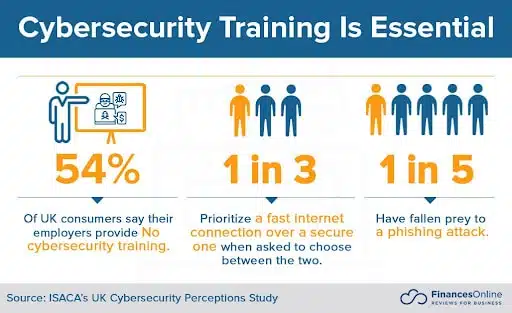When it comes to your cybersecurity strategy, humans will always be your weakest link—and your greatest asset. Educating employees in security awareness is integral to protecting your organization from internal and external cyber threats, and leaders are beginning to recognize the gravity and importance of this fact.
Cybersecurity courses were once treated like an inconvenient tick-box exercise. However, in recent years, new statistics have illuminated the strengths and weaknesses of the human firewall.
68% of organizations have suffered a cyber attack in the last 12 months, and 88% of data breaches are caused by human error. According to Gartner, by 2024, human failure and knowledge gaps will be responsible for over half of significant cyber incidents, showing that your last line of defense really is the person behind the screen.
It’s time to buy a security awareness course, right? As it turns out, not all paid cybersecurity courses are created equal, and the program you choose will determine your employees’ success—and possibly the future of your business.
The Misconception of Content Quantity in Cybersecurity Training
The security awareness training market will exceed $10 billion USD annually by 2027, up from $1 billion USD in 2014. Throughout the last decade, training has proven its value in guarding against cyber attacks, cutting risk by 70% and therefore moving up the C-suite priority list.
Another recent study showed that corporate directors are more willing than ever to educate themselves on cybersecurity. Most importantly, they are willing to invest time, effort, and budget into educating their workforce.
But simply paying for employee training is not enough. Without careful consideration before choosing a paid cybersecurity course provider, you are more likely to encounter the following significant roadblocks:
Problem 1: A Lack of Direction
A course’s structure and content should enable you to effectively identify and work towards your organization’s unique training goals. Training should allow you and your employees to identify and act upon knowledge gaps. Otherwise, you can slip back into ‘tick-box’ territory.
Problem 2: Information Overload
Similarly, taking a ‘quantity over quality’ approach to training can easily overwhelm employees with jargon and information overload, making it more challenging to grasp the essentials and remember what they’ve learned.

Problem 3: No Real Life Relevance
Many IT security professionals report that phishing failure rates remained the same after implementing a training program. Why? Because not all phishing attacks are the same. Your HR team is unlikely to encounter exactly the same threats as your finance team, and vice versa. Employees will become cynical about the training if they fail to see its relevance to their everyday activities.
Problem 4: Boredom and Dismissal
The number of employers that remember all their training has been estimated at 10%—but is it their fault? Boredom is a massive hurdle to effective cybersecurity training, but thankfully, it is easy to overcome. Choosing a paid cybersecurity course provider that offers a good user experience and facilitates feedback will help keep employees engaged throughout the learning process.
What does quality content look like?
Quality content provides more than just information. It creates an immersive learning experience for employees, through which they retain new skills and, most importantly, recognize the relevance of these skills and how to apply them to their roles. Look for the following features when you’re choosing a course provider.
Up-to-Date Course Material
The cybersecurity industry is never at a standstill, so it is imperative to choose a security awareness training program that is regularly updated. For example, 47% of employees have not received training for employee communication applications like Slack and Teams despite their prolific usage in the workplace.
BYOD and remote working policies have transformed how we communicate, and training must keep up with trends, employees’ behavior, and culture—or hackers will stay one step ahead.
Likewise, courses should be up-to-date with new threats, like AI-enabled fraud, and guidelines such as NCSC (National Cyber Security Centre) Standards.
Engagement and Inclusivity Features
Cybersecurity training is for every employee, so you must choose a provider with extensive accessibility and engagement features. Training should be available in multiple languages, and vision, motor, and cognitive impairments should be taken into consideration.

Don’t forget the personalization, too. A surefire way to keep employees engaged is to choose a paid cybersecurity course that automatically personalizes and distributes the content to employees based on factors like their role, location, and performance.
Assessments and Actionable Feedback
Assessments are designed to pinpoint your employees’ successes and struggles so you can improve the efficiency and effectiveness of feedback delivery. Choosing a paid course provider that harnesses analytics and real-time data is an excellent way to optimize content delivery and feedback for each employee based on their results.
Of course, the C-suite and security leaders must stay in the know. The training provider you choose should offer an easy-to-use platform that enables you to monitor performance and improvement analytics.
The Importance of Simulations and Real-World Scenarios
The most impactful feature of a high-quality security awareness solution is the ability to connect cyber threat scenarios to the real world. Simulations help you tailor a training program around:
- Your organization
- Your security policies
- Your industry
- The roles and departments of your employees
- The specific threats they are likely to face
By working through simulations, your employees can learn from a diverse range of relevant challenges and contexts, helping them become more adaptable and vigilant in recognizing threats. Your people will be better prepared for common real-life attacks such as phishing and smishing, and regular simulations ensure that the correct protocols will be fresh in their minds.
It’s important to note that no single security measure is foolproof. An excellent cybersecurity strategy combines awareness training, risk management, identity and access management, security automation tools, and more. These elements create a holistic defense that adapts to the ever-changing threat landscape.

Sure, free and lower-quality courses might appeal to your budget. However, the dividends of simulation training will always be paid back through the risk reduction of preventable security incidents.
Allocate Your Budget to Training Proven to Get Results
When the C-suite decides to allocate a budget to cybersecurity awareness training, it’s a crucial step forward in preventing threats. However, paying for the solution is only the first step—the course you choose will determine your employees’ success and whether the budget is well spent.
Traditional courses offer a vast quantity of content, but they are not always high-quality and relevant to real-world scenarios. Poor quality training is bad for business, security, and your employees’ learning.
In contrast, CybeReady’s unique methodology focuses on the power of simulations, taking a quality-over-quantity approach to maximize the training’s effectiveness. CybeReady addresses the specific needs and challenges faced by your organization and each department within it, then responds with proven training solutions designed to be more retained by your team.
The upshot? It gets the results you need: building cyber resilience into your workplace culture through continuous and engaging training simulations and helping your people develop a multidimensional understanding of today’s critical threats.
Request a demo today to see how CybeReady works in action.













